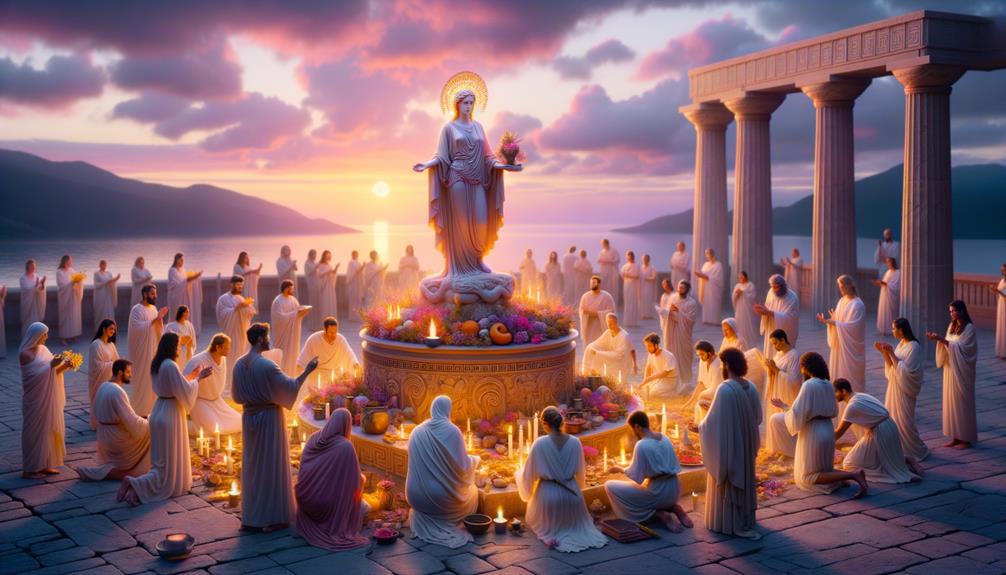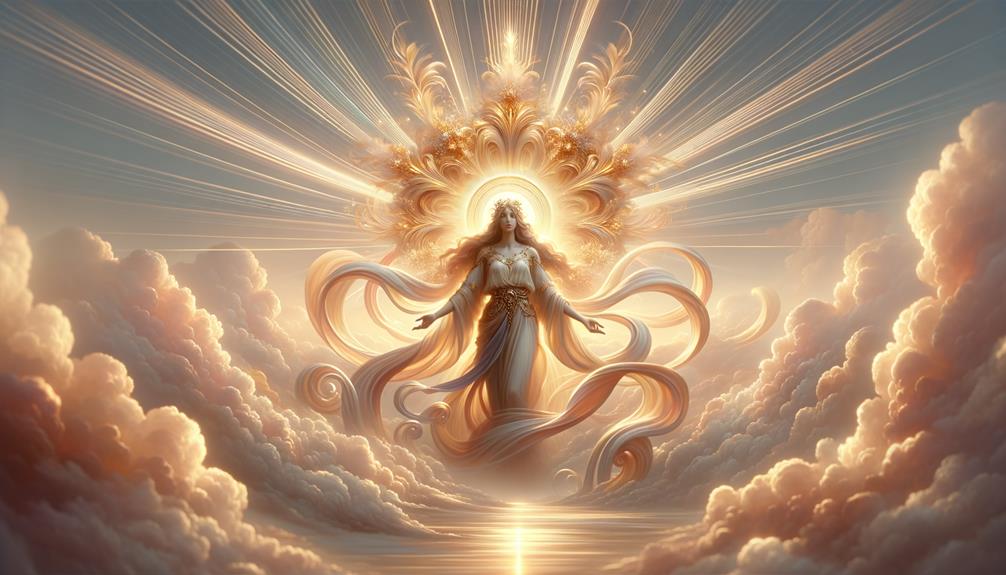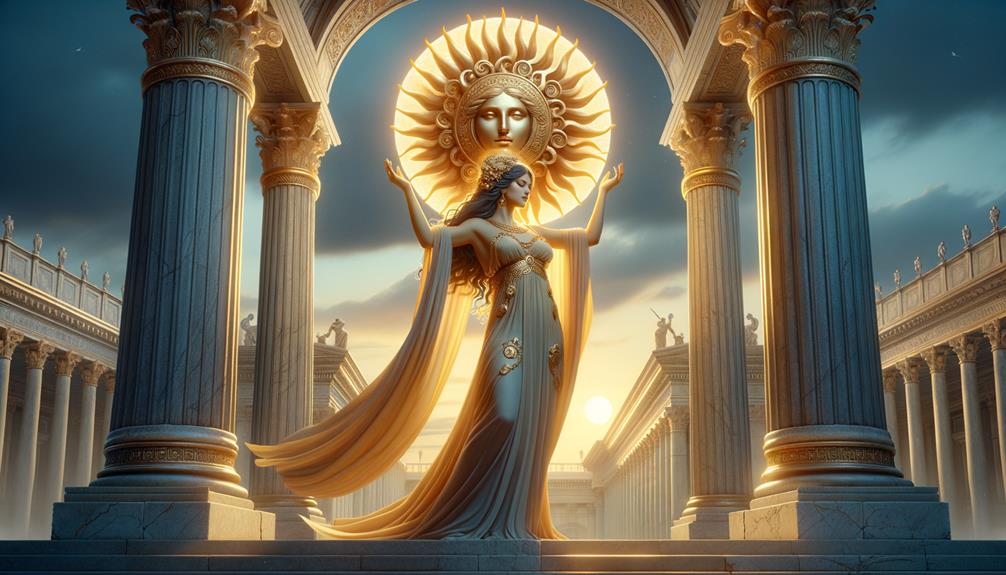In a place where darkness prevails, where shadows waltz and stars glimmer, we find Hemera, the ancient Day Goddess. She’s a beautiful contradiction, a flame birthed from the dark, embodying the balance of order and disorder. Her history is brimming with divine power and intricate connections. However, despite my deep dive into mythology, Hemera’s story is still a mystery, largely unexplored. If you’re curious, come along as we journey into the unknown regions of this age-old deity’s world. It’s high time we unravel Hemera’s story, don’t you think? This one goes out to Sarah who asked us to show Hemera some love.
Unveiling Hemera’s Genealogy

Taking a casual stroll through the misty corridors of Greek mythology, we find ourselves intrigued by Hemera. She’s Nyx’s daughter, the goddess of night, which makes our exploration of her intricate genealogy all the more fascinating. Recognized as the Primordial Goddess of the Day, Hemera’s persona is deeply tied to the idea of light breaking through darkness. However, her family tree is as diverse as the colors of a sunrise. Some tales suggest that she’s the mother of Uranus, while others imply that she’s Cronus’s child. There are also those that associate Hemera with the sun-god Helios, further underscoring her connection to daylight. This mix in lineage reflects the flexible nature of ancient Greek myths, underscoring their capacity to adapt and evolve. It’s a testament to the multilayered mystery that cloaks Hemera’s beginnings.
Hemera in Greek Mythology

Let’s take a look at Hemera, a captivating character from the vast world of Greek mythology. Hemera is known as the Primordial Goddess of the Day. Born from Nyx, the goddess of the night, and Erebus, the embodiment of darkness, Hemera signifies the arrival of daylight after the long night, playing a vital role in maintaining the cosmic order. Her presence underscores the rhythmic cycle of day and night, a signal of time’s passage.
Here are some highlights about Hemera:
- Hemera, a key figure among the ancient deities of Greek mythology, symbolizes the radiant, enlightening aspects of our existence.
- Born from Nyx and Erebus, she is the child of night and darkness.
- Hemera has a significant role in the daily cycle of light and dark, acting as the bridge between the two.
- While she may not be as well-known as some other deities, Hemera’s impact is deeply embedded in the cosmic order.
- Hemera’s intriguing persona and her divine responsibilities serve as a reminder of the delicate balance found in nature.
Hemera and Eos: A Connection

Let’s take a look at an interesting link in Greek mythology: the connection between Hemera and Eos. Hemera is the Primordial Goddess of the Day, while Eos is known for her relationships with humans and her many children. Both play a role in welcoming the light each morning, but their mythological tasks are quite different.
| Hemera | Eos |
|---|---|
| Daytime deity | Dawn deity |
| Represents the day | Interacts with humans |
| Calm and symbolic | Passionate and vengeful |
Hemera stands for the pure light of day, whereas Eos’s stories are filled with passion and revenge. The differences between these two goddesses are not just in their duties but also in their contrasting characteristics in the grand narrative of Greek mythology.
Hemera’s Roman Counterpart: Dies

When we delve into Roman mythology, we come across Dies, who is very much akin to Hemera from Greek mythology. Dies is the personification of the day, symbolizing light and activity. Just as Hemera did in Greek mythology, Dies represents a unique interpretation of day deities in Roman folklore.
- Dies, much like Hemera, is one of the earliest deities in Roman mythology.
- The relationship between Dies and Night isn’t as clearly defined as Hemera’s link to Night in Greek mythology.
- Like Hemera in the Greek pantheon, Dies also has a place in the Roman lineage of gods.
- Hemera is referred to as the daughter of Night in three separate sources, including the ‘Description of Greece’.
- Despite their differences, Hemera and Dies both play crucial roles in the understanding and representation of the day-night cycle.
Worship of Hemera in Ancient Greece

Even though Hemera is depicted as the embodiment of day in Greek mythology, her adoration wasn’t as common or organized as some other Greek gods and goddesses. Back in the day, Hemera was seen more as a part of nature than a unique being to be worshipped. Both Hemera and her brother Aether were recognized in day-to-day life, but they didn’t often become the main focus of ceremonies or religious practices.
| Greek Deity | Characteristics of Adoration |
|---|---|
| Hemera | Not as organized |
| Aether | Likewise not as popular |
| Two Goddesses | Held in higher regard |
| Royal Portico Deity | Frequently adored |
| Typical Greek Deity | Broadly adored |
It’s worth mentioning that Hemera’s importance in Hesiod’s Theogony is less emphasized, even though she plays a crucial role in the universe. This reflects how the break of day, though necessary, frequently goes unnoticed due to its quiet predictability.

